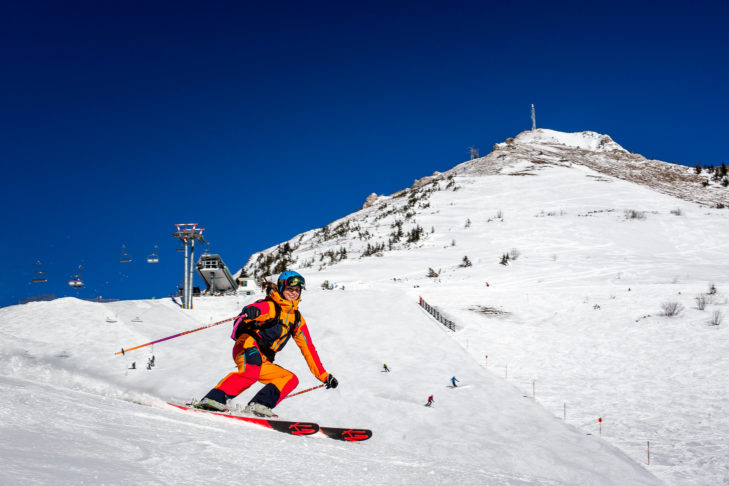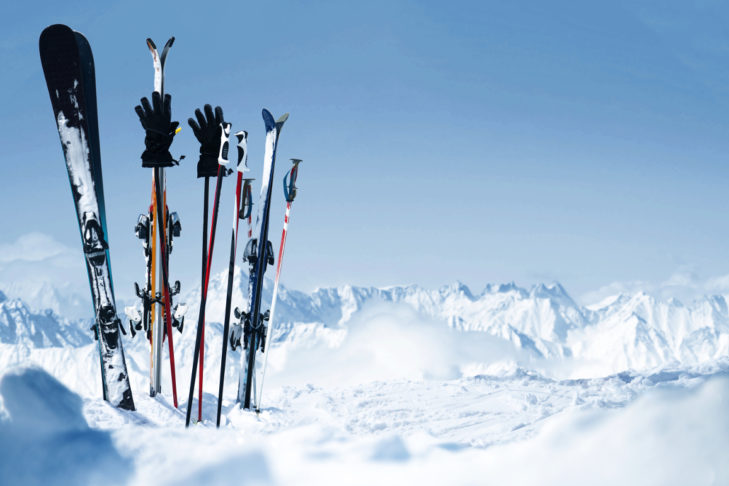The ski pole – an often underestimated accessory in ski equipment. Apparently it is just a metal stick with a handle and a plate. But this impression is deceptive, because a good ski pole can do much more. It stabilises while skiing, supports the course of movement and is the saviour on annoying pulling paths. SnowTrex asked ski instructor Eddy Balduin and Heidi Kreusel, former product expert at the manufacturer LEKI, why ski poles are such important pieces of equipment and what to look out for when buying them.
Why use ski poles?
A good ski pole can improve many a skier’s performance. To do so, it has to be stable, stiff and at the same time as light as possible. Heidi Kreusel can only confirm this. She was Head of Marketing at the ski sports supplier LEKI and knows why ski poles are so important: “They are used to push at the start, during the run for balance and to loosely overcome all the draw paths or off-piste the rough terrain.” A good ski pole therefore conveys stability, safety and drive. Eddy Balduin, a state-certified ski instructor, illustrates this with an example from racing: “If you look at the pros, you immediately see how important ski poles are when skiing. They are needed for balance and stability when skiing. If a racer loses a pole, he no longer has a chance of finishing among the top places.” From beginners to slightly advanced skiers, ski poles provide security and make it easier to climb and move forward on ski lifts. Balduin emphasises that ski poles are also necessary for basics like turn initiation, balance and body tension.
The material
The first ski poles were still made of wood and were held crosswise in front of the body, like an oar. These times have been passé since the beginning of commercial ski tourism at the latest. Today, the simple objects are more sophisticated than ever. “The shafts should be made of either high-strength aluminium (HTS 5.5-6.5) or carbon” recommends expert Kreusel. This makes them light and at the same time unbreakable. Heat-treated aluminium poles only bend when force is applied, but do not break. This reduces the risk of injury and is therefore safer. In the high-end segment, very light and extremely stable carbon fibres are used. The stiff material gives the pole even better cushioning and break resistance. Of course, this quality has its much higher price.
The handle
The handle is made of hard plastic in the simpler models, and of soft or dual density material in more comfortable models, which cushions better and is more comfortable in the hand. With the loops, it is important that they open or detach from the handle quickly in the event of a fall. That’s why Heidi Kreusel recommends, for example, the “Trigger S” developed by LEKI. With this innovative system, the loop is clicked into the grip by means of a ring-like opening, the Trigger Loop on the glove. In the event of a large tensile load, such as a fall, the pole immediately detaches from the body. “You have to get used to it, but after a short period of getting used to it, very few people want to do without it,” says the expert.
The DIN standard
Several characteristics are decisive for a good stick. On the one hand, the weight is decisive. A light stick has less centrifugal mass, puts less strain on the arms, and ultimately has less influence on body movement. In addition, there are the damping properties, because a well-damped stick also protects the wrists. The quality of each cane is defined by the DIN ISO standard 7331. This standard measures, among other things, the resilience of the cane as well as the shape and pressure shock resistance of the handle. The resilience of the material is ultimately indicated by numbers. A 4 value stands for normal quality, a number in the 5 range indicates medium quality, and 6 numbers indicate high-quality construction. Children’s poles, for example, have an F40, Lindsey Vonn’s racing pole was certainly an F65.
The right ski pole length
The length of the pole varies depending on the sport: alpine skiing, ski mountaineering, freestyle, cross-country skiing classic or skating, a different pole is needed for each suitability. The correct cm length for alpine skiers can be determined in various ways. For alpine poles, calculation freaks can use the formula body height times 0.7. A simpler variant is to turn the ski pole upside down and grip it above the plate. When standing upright, the forearm and upper arm should then form a 90 degree angle. Shorter lengths are recommended for beginners.
In cross-country skiing, the length depends on the style – classic or skating – and the level of ability. Generally speaking, the longer the poles, the easier it is to push off. Since gaining momentum is an essential movement feature in cross-country skiing, skating poles in particular are chosen to be very long. The rule of thumb is body height x 0.8 for classic poles and x 0.9 for skating poles.Here is an overview of the rules of thumb:
| Ski poles | Length - model |
|---|---|
| Alpine ski poles | Body height x 0.7 |
| Cross-country ski poles classic | Body height x 0.8 |
| Langlaufstöcke Skating | Body height x 0.9 |
Ski poles for children
Very young ski children don’t need poles? That’s not how ski instructor Eddy sees it. “Actually, poles are used from the first contact with skis on the snow. Also for children, because they save power when moving forward. On top of that, children see their parents as role models, and they usually ski with poles.” In the children’s and youth ski courses (from 6 years old), Eddy has them ski with poles from day one. Heidi Kreusel would give ski children their first poles from the age of 4 or 5, “but it always depends on the individual child, how they coordinate with it. Some children are very early. They really want sticks and they get it, others are completely overwhelmed with it.” Either way, it can’t hurt to use a stick with children who are learning.
Ski poles for freeriders, ski tourers & freestylers
In addition to classic alpine skiing, there are several disciplines that require a special pole. Heidi Kreusel recommends the practical folding poles for freeriders and tourers. “The telescopic models have evolved from the rent-a-ski theme, so the skier can take them handy packed in the bag everywhere.” The adjustment system allows these poles to be flexibly adapted to the slope or for downhill skiing. For off-piste skiers, the difference also lies in the size of the plate. It has a larger diameter and thus a wider surface that grips better in deep snow. To this Kreusel adds, “if you want to go off-piste, the plates should be quick and easy to change, because the small piste plates are no fun when freeriding.” Corresponding replacement models can be bought with every pole.
Poles for racing
There are specially curved poles for alpine racing. They fit snugly around the body and are primarily designed for tight skiing around poles. The normal skier, even if he is a speed skier on the piste, tends not to need these rather expensive racing poles.
Buying tips
- Bring your own glove and check the comfort of the grip and the handling with the loop system. Most models are size-adjustable.
- If you opt for the Trigger S system, you can buy special gloves with an integrated trigger loop directly with it.
- Determine the appropriate length of the pole using the 90-degree angle rule mentioned above.
- Remember that women must not wear heeled shoes when doing this.
- Be aware of what type of pole (fixed or vario) and for what sport you need it.
- Pay attention to the size of the plate. If you want to be equally prepared for the slopes and the terrain, you can buy wider plates to replace them if necessary.
- For fast-growing children, telescopic poles are a good option to “grow with” them. However, they are not as stable as the one-piece models.








